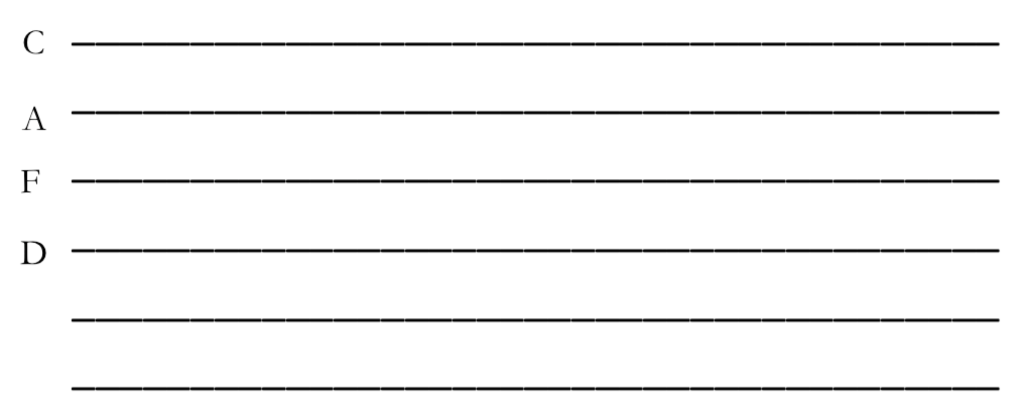This lesson should be preceded by:
Preliminary Lesson 1
Preliminary Lesson 2a
Preliminary Lesson 2b
Intervals
Preliminary Lesson 3

Aim of the Lesson: To teach the Staff (the arbitrary symbol of pitch), and give clear ideas about it.
If you give your child a clear picture of the staff, he will more readily memorize the lines and spaces, he’ll see the necessity for clefs, and he’ll understand that he may make a set of lines to represent any set of sounds.
“We are going to learn how musical sounds are written down.”
Preparation:
We’ve already learned that tunes are made of different pitch (or different sounds.) If we want to learn new tunes, we have to learn how the different pitches and sounds are written down.
Remember the time before you could read books? Mom and dad read you the words in the books. Then you learned how to read the words in your books for yourself.
If we learn to write musical sounds, we can also read them. Let’s learn to write and read pitch sounds.
Method:
a.) PRINCIPLE OF THE STAFF – The sign chosen by musicians to represent a musical sound is a line.

Each line drawn above this line represents the interval of a third.

All we know about the lines pictured above is that they picture a set of sounds a 3rd apart. We don’t know yet which sounds they are.
We’re going to call those above four lines a ladder. Once again, all we know is that a line represents a sound on the piano from one line to the next is the interval of a third.
Suppose we know that the bottom line of this ladder is a F. What are the next three sounds going a third up from F?
Let the student find the sounds on the piano. (This should not be new to the student. In Preliminary Course, Lesson 3, we introduced the drill of teaching the student to go up the keyboard skipping every other key, naming the sounds as he goes.)

If we were going to notate these sounds on our ladder, here’s how we’d label them.

Let’s practice again.
Let’s pretend the bottom line was a D.

Take a look at the keyboard. Let’s determine what the next three lines would be. Find D on the keyboard. Go up in thirds identifying each sound.

Let’s see if we can determine the lines below D.

Go back to D on the keyboard. How do you think we’d fill in the lines below D.
Let’s find where the D sound is on the keyboard. Go down a third. And then go down another third.

Practice:
Give any name and pitch to any line and ask for:
a.) the sounds belonging to the lines above and below.
b.) a sounds two lines above
c.) a sound three lines below, etc.
What do you think the sounds are represented in between the lines?
Summary:
- The pitch of musical sounds is pictured by lines.
- The lines stand for sounds going up in the order of 3rds.
- We cannot tell the names and pitches of lines till one of them is named.
- The one that is named becomes a key to the rest of the ladder.
Homework:
Draw some ladders. Three to six lines is good. Fix a pitch for one line of each ladder and print the letter name on the line. (like pictured above.)
Choose one of the ladder to picture a set of very high sounds.
Choose another ladder to picture a set of very low sounds.
Tell the child to be prepared to explain his ladder to his teacher at his next lesson.
Prepare for the next lesson here: Lesson 4b.
